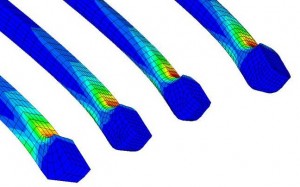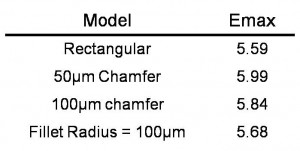
A typical process for making stents is electropolishing to remove material and processing defects and to impart a smooth finish with rounded corners. It is well known that a polished part will have superior fatigue resistance, but how much does the rounding of edges affect the stress and strain in the stent when loaded?
We studied the effect of material removal using a generic Nitinol two-strut stent model. In the figure to the left are four models: From left to right, a typical stent geometry meshed with no consideration for edge detail; a model with a 50 micron chamfer; a model with a 100 micron chamfer; and finally, a model with a 100 micron radius. These four geometries were analyzed by simulating catheter crimp loading. When crimped to minimum dimensions, the strains were as follows:
As can be seen, there is very little impact of the chamfer or the radius on the predicted strain values. These results give credence to the standard practice of neglecting the effect of edge features. It is common, however, to account for the effects of electropolishing by removing an appropriate amount from the as-cut laser geometry. As will be discussed in subsequent posts, verification of actual component geometry is a very important part of the FEA process.

